If there was one fanzine that epitomized the term, “artzine,” it was Infinity, with issue three containing Jeff Jones, Berni Wrightson, Frank Brunner, Michael Kaluta and much more!
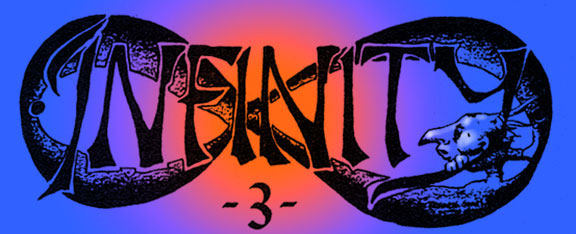
Infinity 3: 1971
Editors and publishers: Adam Malin and Gary Berman
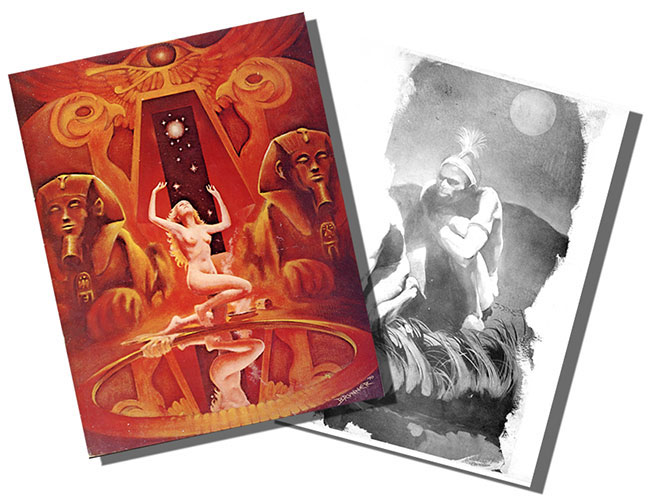
Infinity was one of those fanzines that had it all; incredible art, interviews, professional production and design, all at a consistent level of quality. It seemed editors Malin and Berman wanted nothing but the best…and they usually got it. This issue alone (coming in two volumes) has a list of contributors that is jaw dropping within one issue of a fanzine.
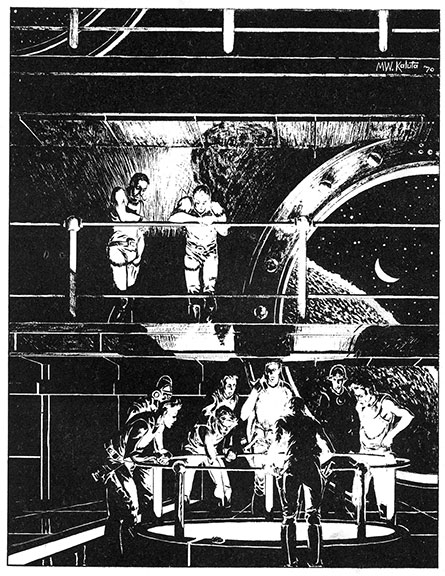
It all starts with the Frank Brunner painting on the cover and continues inside with two Kaluta pieces in a row, one of which you see above (lots to save for the pdfs!). In the editorial, it is mentioned that the first of these two volumes is dedicated to Web of Horror, which I assume means many of the pieces here were slated to appear in th e ill fated fourth issue (if memory serves). Following this is a short Berni Wrightson portfolio, one of which you see at left. His later Studio partner, Jeff Jones follows, with an interview, a few sketches and a small self portrait, seen below.
e ill fated fourth issue (if memory serves). Following this is a short Berni Wrightson portfolio, one of which you see at left. His later Studio partner, Jeff Jones follows, with an interview, a few sketches and a small self portrait, seen below.
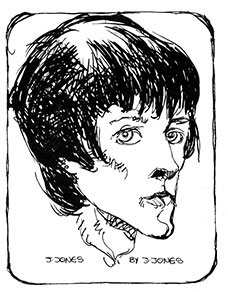
Many of the questions in the interview are ‘what do you think of artist x,’ but there are a few that delve into his practices and techniques…it boggles the mind that, even at this early stage, Jones had already had over 90 paperback covers to his credit. There is also a full page illustration that, in a later issue, is inked by consummate pro, Joe Sinnott. It is hard to think of two artists so different working together!
The next major piece is an interview with Frank Brunner, and it is quite lengthy. Frank was still a relatively new professional at this time, and was contributing to a fair amount of fanzines. In addition to the cover of part one, this interview is graced with 3 full page pieces and 3 smaller ones, one of which you can see below, another within the Adam Malin quote further below.
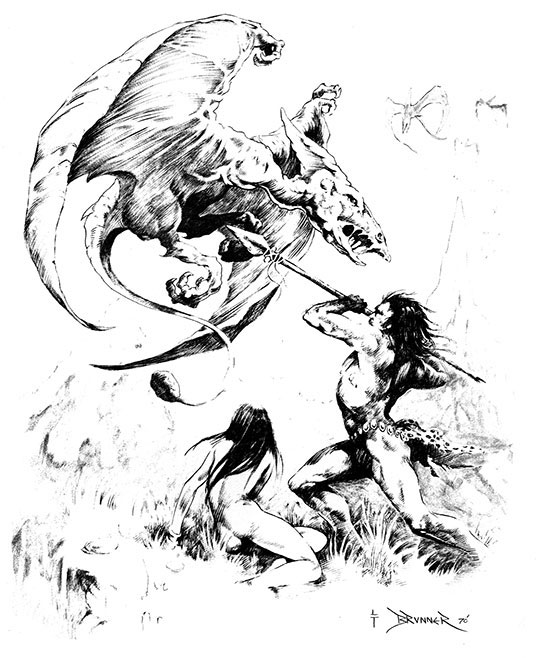
At this time, Brunner still hadn’t weaned himself totally off his Frazetta influence, but it is still beautiful to look at. The last feature in this volume is a strip by Kaluta that I have seen before, and know that it was intended for Web of Horror. You can see the first page below, a great example of his organic style, reminiscent of masters such as Rackham and Robinson.
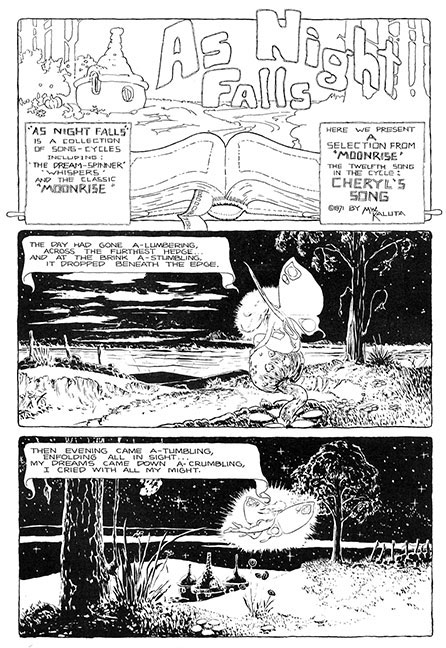
The inside and outside back cover contain a black and white Jeff Jones painting and a color Robert Kline, respectively, which you will see in the pdf, along with tons of other stuff.
Volume 2, all in black and white, starts off with a Jeff Jones painting, followed inside by a Gray Morrow painting, and a typically detailed Kenneth Smith contents page piece. A Bruce Jones story is next, also possibly intended for Web of Horror. Bruce always had a somewhat EC influenced sequential style (he used the Leroy lettering system, like many artists and production people at EC, which heightened the comparison even more), and was at his best doing human figures (photo referenced, I would think). He was also a heavy user of zip-a-tone, to good effect. He is very intelligent and discerning, as you can read in his interview following the story (a page seen below).
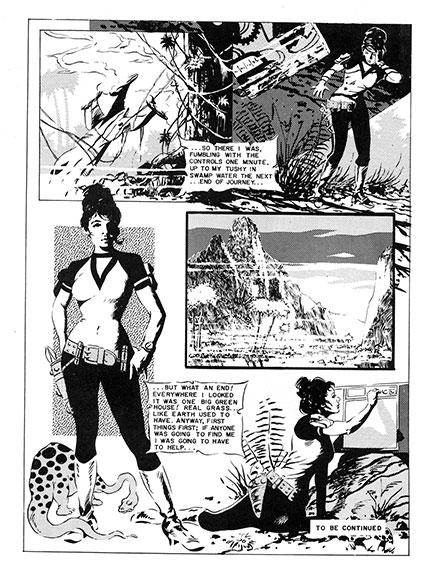
Gary Berman and Adam Malin together created this great zine…and so much more! Via Facebook, Adam shared their journey with me.
OK here’s the short version: Gary and I grew up together on a block of duplexes in Fresh Meadows, New York (on Long Island). We were both comic book fans and I in particular was obsessed with the works of Stan Lee, Jack Kirby and Jim Steranko. Around that time in the back of a Marvel comic book I stumbled on an ad for a fanzine called RBCC (Rockets Blast Comic Collector) which I ordered. And much to my surprise I saw ads from hundreds of people selling off comic books well as for magazines I’d never seen before called fanzines; adapting that concept Gary and I began putting together a fanzine called Infinity.
I was fortunate in that my father was a commercial artist and had experience with paste up work, letra set, Prestone and typeset all of which were mechanical media years before the advent of computer desktop publishing.Our first issue launched in 1970 and through my growing fan acquaintances I was able to gather artwork from some of the notable comic and fantasy artists of the era. By Infinity three we had amassed an impressive collection of work by some of the young masters of the era and with friends such as Doug Murray we were able to interview people like Bernie Wrightson, Frank Frazetta and Mike Kaluta. Concurrent with that our love of the medium and the sci-fi fantasy genre propelled us into producing our first live event in New York City in 1971: Creations Comic Art Convention held at the New Yorker hotel down the block from my dad’s office in Manhattan on 34th St. I used $1000 I had parlayed from three years of being a paperboy as the payment for the meeting space and miraculously we snared Jim Steranko as our first guest! My relationship with Steranko would become a lifelong gift and I still admire him as one of the most visionary masters of the graphic arts medium. I’ll never forget in 1972 for our second show Steranko wanted to come back and stage an incredibly wacky stunt: he comes to me and says, “Adam, you’re going to rent a helicopter and you’re going to have it fly over the Statler Hilton Hotel in Manhattan. I will be suspended on a chain from the bottom of a helicopter upside down in a straitjacket while your attendees wait on the roof of the hotel; at an appointed time I will extricate myself from the straitjacket (Steranko was a Houdini like a magician, very accomplished) and I will drop down to the roof of the Statler Hilton hotel- now that’s something that your attendees will love!” This crazy stunt might’ve actually occurred except for a tragic helicopter accident that happened later that year when a helicopter landed on the heliport on the roof of what was then the Pan Am building that straddles 42nd St. in Manhattan. Winds blew the helicopter off causing massive damage and injury as well as death below. They then enacted a law that prohibited helicopters from landing inside of Manhattan.Anyway we continued publishing Infinity for six issues which was an amazing experience; in concurrence to that we continued running our Creation events. Now amazingly it’s almost 5 decades later and we are about to celebrate our 47th year of live events for fans of the genre (see the site here). It’s been a fabulous ride with much joy and sorrow and drama and I have incredible gratitude for everything that I’ve experienced and we’ve accomplished. I hope future generations of fans will feel equally empowered to pursue their dreams and continue to show the world what a privilege and blessing it is to be a fan in the first place: to love, care for and be passionate about something that is bigger and more wonderful than ourselves!
A fairly expansive Roy Krenkel portfolio follows, with some really beautiful line work serving his usual detailed and fantastic scenes. As stated within the fanzine, everyone seemed to appreciate Roy’s talent but himself. He exhibited such a good eye for composition…notice how the various rock formations point to the saber tooth tiger immediately below.
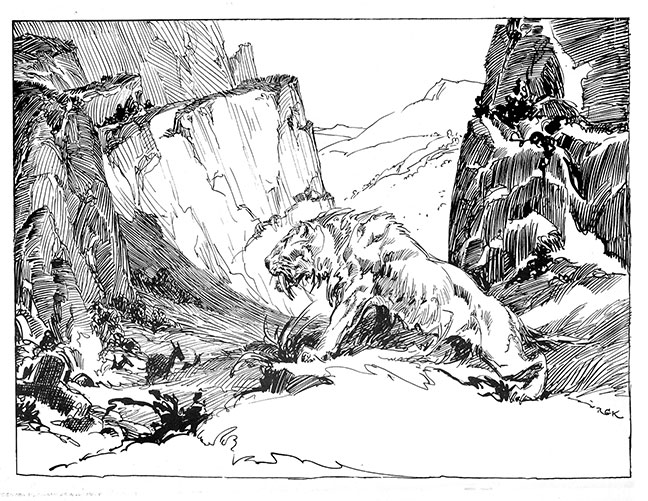
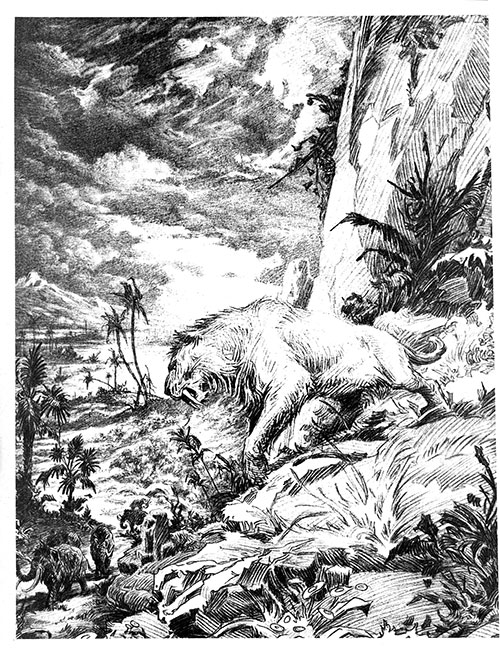
An interesting article about and by Mort Walker of Beetle Bailey fame is next, detailing the various personnel involved in this strip and a few others.
I have no clue how the next two pages of Mort Drucker’s work fit into Infinity, or where they came from or what they were intended for, but considering it’s Mort Drucker, it’s very easy to just revel in the gorgeous draftsmanship.
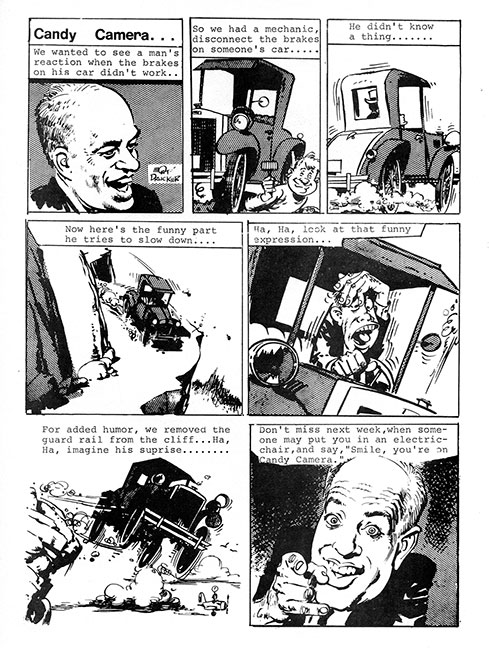
The letters page follows, with illustrations by Kenneth Smith, Brunner, Tom Yeates, an Al Williamson sketch (which says more than most artist’s finished work), and one unsigned piece. After that are a couple of strange Wally Wood creatures and a Wrightson back cover. But, there is more! A multi page pamphlet of sorts is included, with sketches by Kirby, Frazetta, Williamson, Tom Yeates and the lively Syd Shores illustration of Cap seen below. It is explained within the pages there that people had complained a bit about the plethora of sketches in previous issues, so the editors filled the pages of this additional group of pages with sketches.
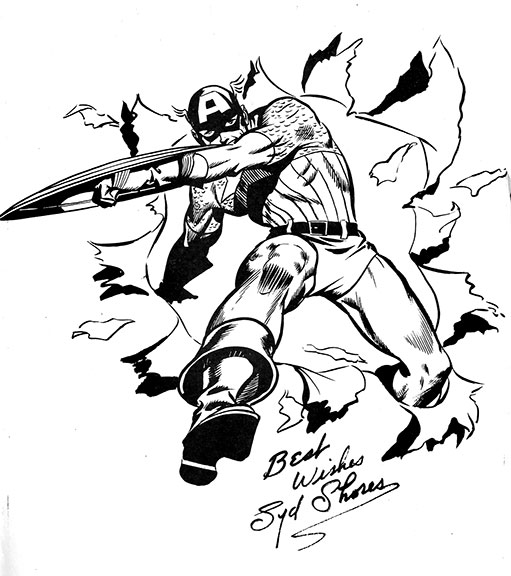
…and that about wraps it up! Remember, the pdf shows it all, and there is so much more to see! I hope you enjoyed this foray into one of the best fanzines ever published. I have another issue or two loaned to me, like this one, by the generous Herb Warren, so keep yer eyes peeled! Additional thanks to Adam Malin. Don’t forget to go here to gain access to the pdf and all previous columns.
Ken Meyer Jr.
kenmeyerjr@yahoo.com


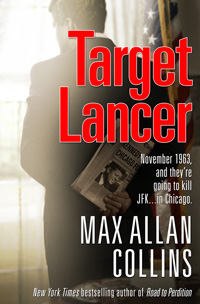
This may be a remedial question but I just wanted to know the difference between a fanzine and a comic. From what I’m noticing from many of your posts is that the fanzines were a collection of various stories from a lot of different creators. Were they also printed on larger paper than the comics that came out around that time period?
Sorry if you’ve answered this before.